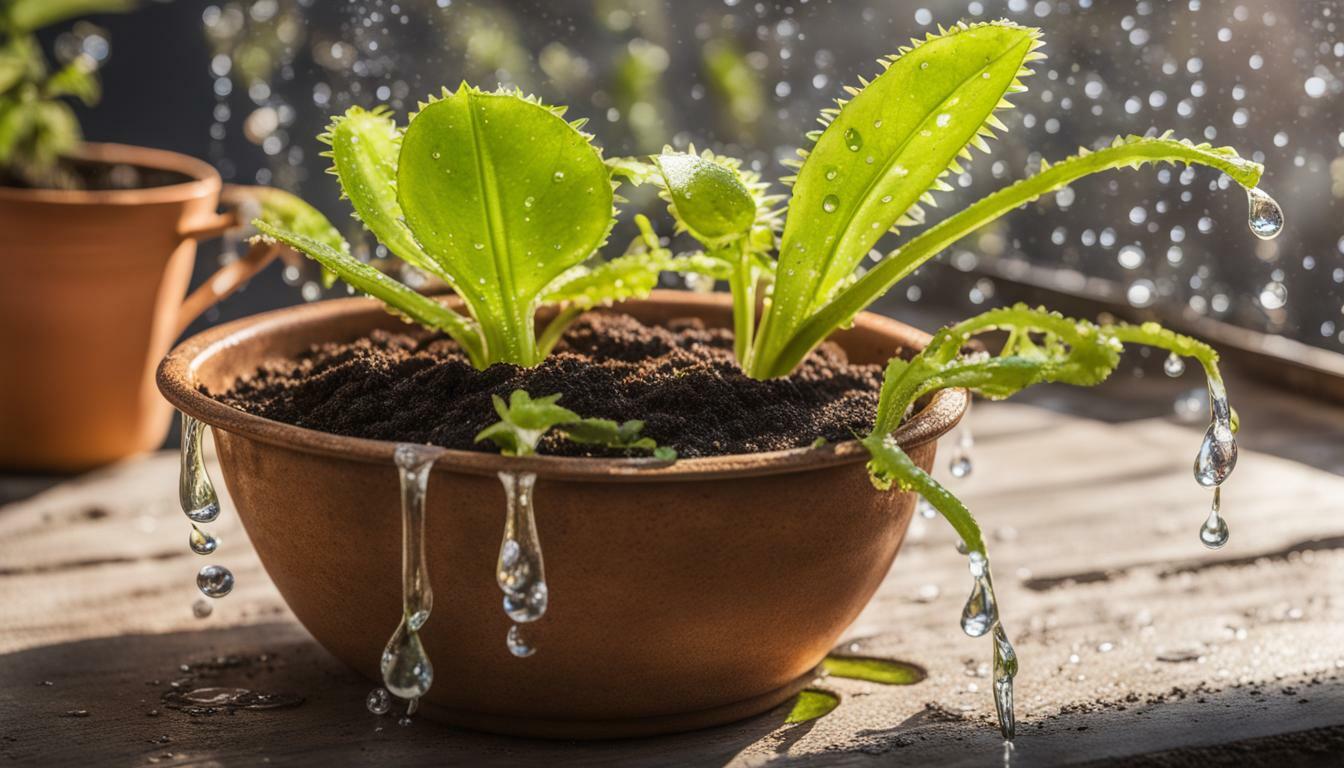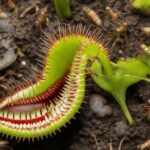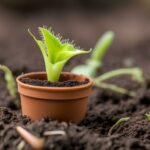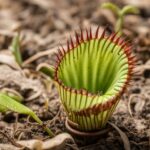Have you just acquired a Venus flytrap and wondering how often to water it? Watering these carnivorous plants is a crucial aspect of their care as they require a specific level of moisture to thrive. In this section, we will explore the optimal watering practices for Venus flytraps and provide tips on how to maintain the right moisture levels for these fascinating plants.
Key Takeaways:
- The frequency of watering a Venus flytrap is an essential aspect of its care.
- Proper watering practices ensure the well-being and longevity of your Venus flytrap.
- Factors like environmental conditions, season, and potting medium affect watering frequency.
Understanding Venus Flytrap Watering Needs
Venus flytraps are unique plants that require specific watering needs to thrive. Understanding the watering schedule for your Venus flytrap is crucial to ensure that it receives the appropriate amount of moisture.
How much water does a Venus flytrap need?
| Plant Age | Water Amount |
|---|---|
| 0-6 months | 1-2 inches of water every 3-4 days |
| 6 months-1 year | 2-3 inches of water every 5-6 days |
| 1-2 years | 3-4 inches of water every 7-8 days |
Venus flytrap moisture requirements
Venus flytraps require a moist, but not waterlogged soil environment. The soil should be evenly moist at all times, which can be achieved by using a planting mix that retains moisture without becoming waterlogged. The potting mix should be typically be a mix of peat moss and perlite, a mixture that retains moisture without being too dense.
It is important to avoid keeping Venus flytraps in standing water as this can lead to root rot and other fungal infections. A saucer or dish can be used to catch excess water but should be emptied frequently to avoid waterlogging the soil.
Watering schedule for Venus flytrap
The watering schedule for Venus flytraps will vary depending on the environment, season, and potting medium. In general, Venus flytraps should be watered when the top layer of soil feels dry to the touch. Always use distilled or rainwater, as tap water contains minerals that can be harmful to the plant.
During the growing season (spring and summer), Venus flytraps may require more frequent watering to maintain their moisture levels. In contrast, during the dormancy period (fall and winter), Venus flytraps require less water and should be watered only when the soil feels dry.
In Conclusion
Understanding the watering needs of a Venus flytrap is crucial to its overall health. Knowing the moisture requirements, watering schedule, and the appropriate amount of water for your plant will ensure its longevity. Remember to avoid overwatering or underwatering and take the necessary steps to maintain the right moisture levels for your Venus flytrap.
Factors Affecting Venus Flytrap Watering Frequency
Now that you understand the specific water requirements of Venus flytraps, it’s crucial to consider the factors that affect their watering frequency. By doing so, you can create an optimal watering schedule that ensures your Venus flytrap receives the right amount of moisture.
Environmental Factors: One of the primary factors that affect Venus flytrap watering needs is the environment. These plants thrive in a humid environment with ample sunlight. If your Venus flytrap is placed in a dry or arid location, it may require more frequent watering. On the other hand, if it’s placed in a humid area, it may require less watering.
Seasonal Factors: Another important factor is the season. During the hot summer months, Venus flytraps tend to grow faster and may require more watering than in the colder months. During winter, when the plant is dormant, it will require less watering.
Potting Medium: The type of potting medium used for Venus flytraps can also impact their watering frequency. A mix of peat moss and sand is ideal for Venus flytraps, as it provides adequate moisture retention and drainage. If your potting medium is too compact or dense, it may retain too much water, leading to overwatering. If it’s too loose or sandy, it may not retain enough moisture, resulting in underwatering.
Venus Flytrap Watering Guide: To determine the optimal watering frequency for your Venus flytrap, follow this general guide. Water your plant thoroughly when the soil is dry to the touch. Avoid allowing the potting medium to completely dry out, as this can damage the roots. Similarly, avoid overwatering, as this can lead to root rot and other issues.
- For younger Venus flytraps, water them once a week.
- For mature Venus flytraps, water them once every two weeks.
Watering Tips: To ensure your Venus flytrap receives the right amount of water, consider these tips:
- Use distilled or rainwater instead of tap water, which may contain minerals and other chemicals that can harm your plant.
- Water the plant from the bottom by placing the pot in a tray of water. This allows the plant to absorb the water it needs from the potting medium. Alternatively, water the plant from above, but avoid getting water on the leaves or traps.
- Ensure proper drainage by selecting a pot with drainage holes and avoiding waterlogged conditions.
By considering these factors and following the watering guide and tips, you can ensure optimal watering for your Venus flytrap. This will enable it to thrive and capture the fascination of all who encounter it.
Signs of Overwatering and Underwatering
As a Venus flytrap owner, determining the right amount of water to provide your plant can be a tricky balancing act. Underwatering can cause wilting and eventual death, while overwatering can lead to root rot and other complications. Here are some signs to look out for:
Signs of Overwatering
If you notice any of the following signs, your Venus flytrap may be receiving too much water:
- Yellow leaves
- Black or brown roots
- Mushy leaves
- Foul odor
If you notice any of these signs, it’s important to reduce the amount of water you’re providing your Venus flytrap and adjust your watering schedule accordingly.
Signs of Underwatering
On the other hand, if you see the following signs, your Venus flytrap may be receiving too little water:
- Wilting leaves
- Dried-out soil
- Pale or yellow leaves
- Slow growth
If you notice any of these signs, it’s important to increase the frequency of watering your Venus flytrap to ensure it is adequately hydrated.
Best Practices for Watering a Venus Flytrap
Watering a Venus flytrap may seem like a daunting task, but fear not! With these best practices, you’ll be able to provide your plant with the right amount of water to thrive.
Use Distilled or Rainwater
Venus flytraps are sensitive to the minerals found in tap water, which can harm their growth. To avoid this, use distilled or rainwater for watering your plant. You can collect rainwater with a bucket or use a dehumidifier to gather distilled water.
Watering Techniques
When watering your Venus flytrap, be sure to water the soil and not the plant itself. Water the soil until it’s moist, but not saturated. You want to avoid waterlogging the roots, which can cause rot.
It’s also important to avoid misting your Venus flytrap, as this can cause over-saturation of the leaves.
Maintain Proper Drainage
Venus flytraps require well-draining soil. To ensure proper drainage, use a pot with drainage holes and a soil mixture that contains perlite or sand. This will prevent water from accumulating at the bottom of the pot and causing root rot.
Frequency
The frequency of watering your Venus flytrap will depend on several factors, such as the season and environment. During the growing season (spring and summer), water your plant once or twice a week. In the winter, reduce watering to once every two weeks.
It’s important to monitor the moisture level of the soil and adjust your watering schedule accordingly. If the soil feels moist, wait until it dries out before watering again.
With these best practices, watering your Venus flytrap can be a breeze. Remember to use distilled or rainwater, water the soil only, maintain proper drainage, and adjust your watering frequency based on the season and soil moisture level.
Conclusion
As you have learned, watering a Venus flytrap requires some specific knowledge and care. It’s important to understand that these plants have unique moisture requirements and can suffer if they are overwatered or underwatered. To ensure that your Venus flytrap thrives, it’s important to follow some best practices, including:
- Using distilled or rainwater
- Watering your plants regularly
- Ensuring proper drainage
Pay Attention to Your Plant’s Needs
Remember that every Venus flytrap is unique and may require slight variations in watering habits. Pay close attention to your plant’s behavior and adjust your watering schedule accordingly. If you see signs of overwatering or underwatering, take immediate action to address the issue.
Creating an Optimal Environment
Aside from watering, it’s also important to create an optimal environment for your Venus flytrap. This includes providing them with adequate sunlight, avoiding excessively high or low temperatures, and ensuring proper soil conditions. By taking into account all of these factors, you can create an ideal growing environment for your Venus flytrap.
With the right care and attention, your Venus flytrap will thrive and continue to be a fascinating addition to your home or garden. Follow the guidelines and tips provided in this article, and you’ll be well on your way to growing a healthy and vibrant Venus flytrap.
Do Venus Flytraps Need Other Insects to Survive?
Venus flytraps, known for their unique mechanism, rely on venus flytraps attracting other insects to satisfy their nutritional needs. These carnivorous plants lure unsuspecting insects with their colorful leaves and sweet nectar. Once an insect lands on the trigger hairs inside the plant’s trap, it causes a rapid closure resulting in the insect’s capture. As the flytrap digests the insect, it absorbs essential nutrients for survival, showcasing its fascinating adaptation to acquire nourishment.
FAQ
Q: How often should you water a Venus Flytrap?
A: The frequency of watering a Venus Flytrap depends on various factors such as the environment, season, and potting medium. As a general guideline, it is recommended to keep the soil consistently moist but not waterlogged. You may need to water your Venus Flytrap 1-2 times a week during the growing season, and less frequently during the dormant period.
Q: What are the signs of overwatering and underwatering a Venus Flytrap?
A: Overwatering can lead to the roots rotting and the plant becoming weak and droopy. The leaves may turn brown or black, and the traps may fail to close. On the other hand, signs of underwatering include wilting leaves, yellowing or browning of the traps, and a general lack of growth. It’s essential to find a balance and maintain the right moisture levels for the health of your Venus Flytrap.
Q: What is the best way to water a Venus Flytrap?
A: It is recommended to use distilled or rainwater for watering Venus Flytraps as they are highly sensitive to minerals and chemicals present in tap water. Avoid using water that has been treated with water softeners or filtered through reverse osmosis systems. When watering, ensure that the water reaches the roots and the soil is thoroughly moistened without creating standing water. Proper drainage is crucial for Venus Flytraps to prevent waterlogged conditions.
Q: How can I adjust the watering frequency based on the seasons?
A: During the active growth period, which is usually during spring and summer, Venus Flytraps require more frequent watering to support their growth. As the plants enter the dormant period in fall and winter, their water requirements decrease. It’s important to monitor the moisture levels and adjust the watering frequency accordingly.
Q: Can I mist my Venus Flytrap instead of watering it?
A: While misting can provide some humidity, it is not sufficient for meeting the watering needs of Venus Flytraps. These plants require a thorough watering to ensure that the roots receive enough moisture. Misting alone may not provide the necessary hydration and could lead to inadequate moisture levels.
Q: Should I keep my Venus Flytrap in a tray of water?
A: No, it is not recommended to keep Venus Flytraps in a tray of water as this can lead to waterlogged conditions and root rot. These plants prefer moist soil, but not standing water. It’s important to allow excess water to drain out completely to prevent any harm to the plant.
Q: How can I prevent overwatering my Venus Flytrap?
A: To prevent overwatering, monitor the moisture levels of the soil before watering and ensure that the potting medium is well-draining. Use a pot with drainage holes to allow excess water to escape. Additionally, avoid misting the plant excessively or keeping it in a high-humidity environment for extended periods. By practicing proper watering techniques and understanding the needs of your Venus Flytrap, you can prevent overwatering and maintain its health.










